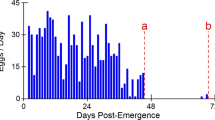Abstract
The ubiquity of circadian rhythms suggests that they have an intrinsic adaptive value (Ouyang et al. 1998; Ronneberg and Foster 1997). Some experiments have shown that organisms have enhanced longevity, development time or growth rates when maintained in environments whose periodicity closely matches their endogenous period (Aschoff et al. 1971; Highkin and Hanson 1954; Hillman 1956; Pittendrigh and Minis 1972; Went 1960). So far there has been no experimental evidence to show that circadian rhythms per se (i.e. periodicity itself, as opposed to phasing properties of a rhythm) confer a fitness advantage. We show that the circadian eclosion rhythm persists in a population of the fruitfly Drosophila melanogaster maintained in constant conditions of light, temperature, and humidity for over 600 generations. The results suggest that even in the absence of any environmental cycle there exists some intrinsic fitness value of circadian rhythms.
Similar content being viewed by others
Author information
Authors and Affiliations
Additional information
Received: 2 November 1998 / Accepted in revised form: 22 April 1999
Rights and permissions
About this article
Cite this article
Sheeba, V., Sharma, V., Chandrashekaran, M. et al. Persistence of Eclosion Rhythm in Drosophila melanogaster After 600 Generations in an Aperiodic Environment. Naturwissenschaften 86, 448–449 (1999). https://doi.org/10.1007/s001140050651
Issue Date:
DOI: https://doi.org/10.1007/s001140050651




